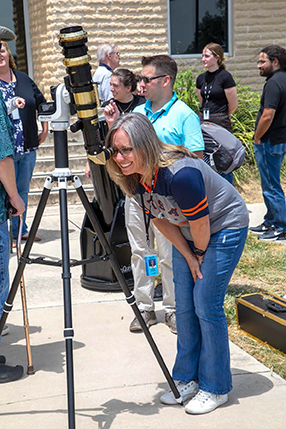Caleb Gimar wants you to give the sky a little more attention. Gimar, a Ph.D. candidate in the The University of Texas at San Antonio-SwRI Space Physics Graduate Program, gave a talk, “Adventures in Amateur Astronomy” at the SwRI library and again at Bldg. 263 to interested SwRI staff about how to get involved with amateur astronomy.
“Something that’s interesting is that even though a lot of us work with various spacecraft going to planets and making in situ observations, a lot of people in this field don’t do a lot of observing themselves,” he said.
Gimar began observing when he was seven years old. He had been fascinated by space and science for some time already. He saved money he had received at Christmas and on his birthday, and even sold some toys he no longer played with, to buy himself an eight-inch-diameter telescope, which he still owns.
He has continued to observe, graduating to larger tele scopes over time. While a student at Wichita State University, he worked as a space science educator at the Cosmosphere International SciEd Center and Space Museum in Hutchinson, Kansas, participating in astronomy outreach activities.
“Most people don’t realize that you don’t really need a high magnification telescope to see some of the best stuff in the sky,” Gimar said. “You only need a good pair of binoculars
to get started. There’s a lot of nice open clusters and diffuse nebulae. Things like that are very easily seen under a dark sky.”
According to Gimar, an early challenge for most amateur astronomers is learning the sky and where various objects are located as well as believing that they are going to see some thing similar to the images the Hubble Space Telescope has captured.
“You won’t see extremely high-definition, well-magnified images, but what you will see is very rewarding,” he said. “The first time you see the cloud bands on Jupiter or the rings of Saturn, it is a jaw-dropping experience.”
Gimar frequently makes observations at the Curtis Vaughn Jr. Memorial Observatory at UTSA and meets with the San Antonio League of Sidewalk Astronomers on the first and sec ond Fridays of the month for amateur astronomy nights, which are open to the public.
“Seeing is believing. You can have all the photographs come back from all the spacecraft out there, and there’s still a barrier there,” he said. “When you’re looking through a telescope at the sky, those photons that are being emitted or reflected by the object you’re looking at are striking your eyes directly. It is being focused by that telescope and striking the cells in your eyes so that the light that you’re seeing is making that journey clear across space and actually interacting with you. In turn, you are reaching out into the cosmos and becoming a part of it.”
Four groups across SwRI participated in the two events including Women in Science and Engineering (WiSE), The University of Texas at San Antonio Graduate Student Program, the Space Data Systems Group, and Young Engineers and Scientists (YES).
–Joanna Quintanilla


